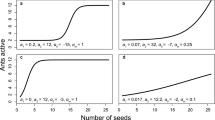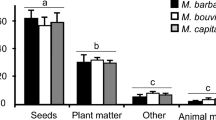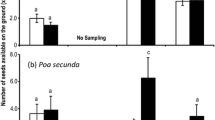Abstract
Harvester ants are important seed predators in many xeric environments, and their foraging choices can influence the composition of plant communities. Seed abundance has been cited as an important factor in determining such foraging preferences. Three seed types (sesame, millet, and flax) were experimentally introduced in differing proportions near nests of the ant Messor ebeninus near the Dead Sea, in territory administered by the state of Israel. Two experiments were designed to investigate the effects of this density conditioning on two stages of the ants' subsequent foraging behavior: recruitment to seed patches and selection of seeds from within a patch. When seeds were presented in small, single-species patches, experimentally common seeds were discovered and exploited significantly faster than rare seeds, especially among less preferred seed types. When seeds were presented in large, mixed patches, however, no consistent effect of density was observed.
Similar content being viewed by others
References
Bailey KH, Polis GA (1987) Optimal and central-place foraging theory applied to a desert harvester ant, Pogonomyrmex californicus. Oecologia 72:440–448
Best LS (1981) The effect of specific fruit and plant characteristics on seed dispersal. PhD Thesis, University of Washington, Seattle
Briese DT (1982) Relationship between the seed-harvesting ants and the plant communityin a semi-arid environment. In: Buckley RC (ed) Geobotany, 4: Ant-plant interactions in Australia. Junk, The Hague, pp 11–24
Brown JH, Davidson DW, Reichman OJ (1979) An experimental study of competition between seed-eating desert rodents and ants. Am Zool 19:1129–1143
Cates RG, Orians GH (1975) Successional status and the palatability of plants to generalist herbivores. Ecology 56:410–418
Crist TO, MacMahon JA (1992) Harvester ant foraging and shrubsteppe seeds: interactions of seed resources and seed use. Ecology 73: 1768–1779
Davidson DW (1978) Experimental tests of the optimal diet in two social insects. Behav Ecol Sociobiol 4:35–41
Feeny P (1975) Biochemical coevolution between plants and their insect herbivores. In: Gilbert LE, Raven PH (eds) Coevolution of animals and plants. University of Texas Press, Austin, pp 3–19
Gibbs RD (1974) Chemotaxonomy of flowering plants, vol 1. Constituents. McGill-Queens University Press, Montreal
Gordon DM (1983) The relation of recruitment rate to activity rhythms in the harvester ant Pogonomyrmex barbatus. J Kansas Entomol Soc 56: 277–285
Hassell MP (1976) Arthropod predator-prey systems. In: May RM (ed) Theoretical ecology: principles and applications. Saunders, Philadelphia, pp 71–93
Hobbs RJ (1985) Harvester ant foraging and plant species distribution in annual grassland. Oecologia 67:519–523
Holldobler B, Wilson EO (1990) The ants. Belknap Press, Cambridge
Holling CS (1959) Some characteristics of simple types of predation and parasitism. Can Entomol 91:385–398
Houston AI, Krebs JR, Erichsen JT (1980) Optimal prey choice and discrimination time in the great tit (Parus major L.). Behav Ecol Sociob 6:169–175
Ivlev VS (1961) Experimental ecology of the feeding of fishes. Yale University Press, New Haven
Kunin WE (1991) Few and far between: plant population density and its effects on insect-plant interactions. PhD Thesis. University of Washington, Seattle
Menge BA, Sutherland JP (1976) Species diversity gradients: synthesis of the roles of predation, competition, and temporal heterogeneity. Am Nat 110:351–369
Paine RT (1966) Food web complexity and species diversity. Am Nat 100:65–75
Pietrewicz AT, Kamil AC (1981) Search images and the detection of cryptic prey: an operant approach. In: Kamil AC, Sargent TD (eds) Foraging behavior: ecological, ethological, and psychological approaches. Garland STPM, New York, pp 311–331
Reichman OJ (1979) Desert granivore foraging and its impact on seed densities and distributions. Ecology 60:1085–1092
Rhoades DF, Cates RG (1976) Towards a general theory of plant antiherbivore chemistry. In: Wallace JW, Mansell RL (eds) Biochemical interaction between plants and insects. Plenum, New York, pp 168–213
Rissing SW (1981) Foraging specializations of individual seed-harvester ants. Behav Ecol Sociob 9:149–152
Rogers LE (1974) Foraging activity of the western harvester ant in the shortgrass plains ecosystem. Environ Entomol 3:420–424
Stephens DW, Krebs JR (1986) Foraging theory, Princeton University Press, Princeton
Tevis L Jr (1958) Interrelations between the harvester ant Veromessor pergandei (Mayr) and some desert ephemerals. Ecology 39:695–704
Tinbergen L (1960) The natural control of insects in pinewoods. I. factors influencing the intensity of predation by songbirds. Arch Neerl Zool 13:266–336
Tukey JW (1977) Exploratory data analysis. Addison-Wesley, Reading, Mass
Whitford WG (1978) Foraging by seed-harvesting ants. In: Brian MV (ed) Production ecology of ants and termites. Cambridge University Press, Cambridge, pp 107–110 Wilkinson L (1989) SYSTAT: the system for statistics for the PC (Version 4) SYSTAT, Evanston
Author information
Authors and Affiliations
Rights and permissions
About this article
Cite this article
Kunin, W.E. Density-dependent foraging in the harvester ant Messor ebeninus: two experiments. Oecologia 98, 328–335 (1994). https://doi.org/10.1007/BF00324221
Received:
Accepted:
Issue Date:
DOI: https://doi.org/10.1007/BF00324221




